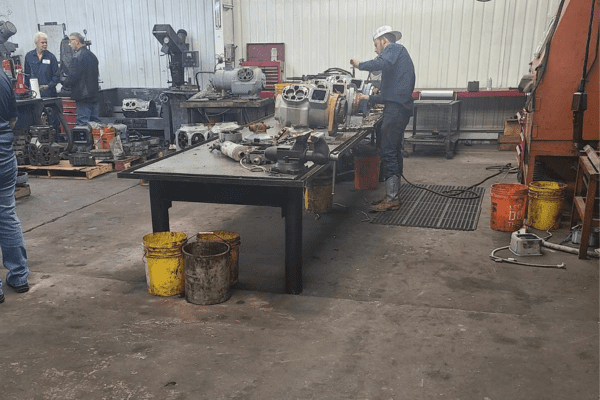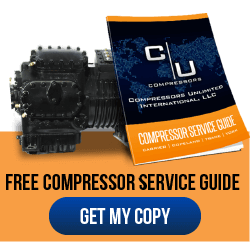When it comes to compressor maintenance, refrigerant leaks are among the biggest issues to be aware of and prevent. While there are many reasons for refrigerant leaks, refrigerant line vibration is a contributing factor in nearly all cases. Line vibration makes the refrigerant line more prone to damage from other sources.
How Does Refrigerant Line Vibration Contribute to Leakage and Compressor Damage?
Refrigerant line vibration is not usually the main cause of leakage, but it makes leakage more likely whenever any other issues arise within the system. By preventing line vibration, you are far more likely to stop leaks by following a regular compressor maintenance schedule.
On the other hand, uncontrolled line vibration is one factor that can aggravate other mechanical issues and lead to sudden, unexpected breakdowns. There are three main ways line vibration undermines your system and can produce component failures far from the refrigerant line itself:
1. Metal Fatigue
Compressor refrigerant lines experience repeated cycles of vibration through continuous, intensive operation. This can cause metal fatigue in the connectors and lines. Over time, fatigued metal components may develop cracks, requiring replacement. Untreated cracks can widen to cause leaks.
2. Loosening of Joints and Fittings
Fittings are among the compressor components that should always be replaced when a compressor is being remanufactured. This is because they are natural structural weak points that absorb vibrational forces. Leak paths are created as joints and fittings lose integrity.
3. Abrasion
Vibration exacerbates direct contact between the refrigerant line and other surfaces, leading to abrasion. The thinning of the refrigerant line can result in leaks. Like most other forms of line damage, the best response is a replacement of the refrigerant line.
Mitigating Line Vibration in Commercial Compressors
Line vibration is a particularly challenging matter because it can be caused by natural harmonic resonance. Each material has its own resonance frequency. If the vibrational frequency of the refrigerant line happens to match that of the materials, it leads to resonance.
Resonance can amplify vibrations that are already coming from other sources. Vibrations can even occur at several different frequencies at once, combining to create a greater disturbance. Luckily, a range of different mitigation strategies are available that can reduce line vibration from all sources.
Much of the work of reducing refrigerant line vibration is done during initial system installation. Dampers and isolators can be installed to curb the amount of vibration that reaches the refrigerant line. This is especially key in cases of unavoidable vibration. For instance, reciprocating compressors experience vibration with the piston action.
Sound compressor installation practices can save you a lot of headaches. Still, that doesn’t mean you have no options at all if your system is already in place and has been operating for years. Refrigerant line vibration mitigation strategies include:
- Anti-Vibration Mounts: These reduce the overall vibrational burden in the system.
- Regular Maintenance: Refrigerant lines should be inspected for cracks regularly.
- Joint and Fixture Replacement: O-rings and other parts should be replaced as needed.
Even with the best system architecture, line vibration is a perennial concern in compressor maintenance. While many compressor manufacturers are incorporating vibration reduction technologies in their designs, Carrier has gone beyond the rest with modern approaches that help you get the most from your compressor.
Carrier Paragon Compressors Help You Prevent Line Vibration
Carrier Paragon compressors elevate this brand’s long history to a new standard of quality, reliability, and ease of maintenance. There are several elements of the Carrier Paragon design that make it more resistant to line vibration and other common issues that can plague even the best maintenance team.
As a general rule, you can expect a compressor that makes a lot of noise is also experiencing a lot of vibration. With a more compact design, Carrier Paragon screw compressors are smaller and lighter than the reciprocating compressors they’re most often compared to, inherently reducing vibration risk.
With fewer moving parts, you’ll also see less mechanical vibration along with fewer points of fault. All in all, there are simply less things that can go wrong with a Carrier Paragon compressor. That also makes it easy to diagnose issues when they do happen, so you can identify the root cause of line vibration.
A Remanufactured Carrier Paragon Compressor Is the Solution You’ve Been Waiting for
With commercial compressor remanufacturing, your Carrier Paragon compressor core is used as the basis of a unit that meets all of your expectations for performance, reliability, and environmental impact. Plus, it can be sourced faster and at a discount compared to OEM-affiliated wholesalers.
If you’ve had troubles with refrigerant line vibration in the past, your compressor remanufacturing team can advise you on the possible causes. That adds to the longevity and efficiency of your remanufactured unit so you’ll enjoy superior performance for its entire 8-10 years of service.












